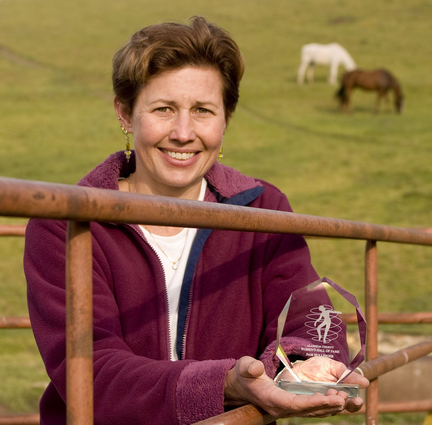Pam Hullinger to be inducted into the Alameda County Women's Hall of Fame
 (Download Image)
Photo by Joseph Martinez Pam Hullinger, the chief veterinary officer and leader of the Food and Agricultural Security Program at LLNL, will be inducted Saturday into the Alameda County Women's Hall of Fame. Shown above, Hullinger was one of the speakers at a May 2006 press conference at the UC Davis about the development of a more rapid diagnostic test that simultaneously checks for foot-and-mouth disease and six other similar diseases in livestock.
(Download Image)
Photo by Joseph Martinez Pam Hullinger, the chief veterinary officer and leader of the Food and Agricultural Security Program at LLNL, will be inducted Saturday into the Alameda County Women's Hall of Fame. Shown above, Hullinger was one of the speakers at a May 2006 press conference at the UC Davis about the development of a more rapid diagnostic test that simultaneously checks for foot-and-mouth disease and six other similar diseases in livestock.
As a youngster growing up within earshot of the Santa Anita Park racetrack in Arcadia, Pam Hullinger always knew she wanted to become a horse doctor or some type of veterinarian.
Hullinger’s childhood dream was realized in 1990 when she graduated as a doctor of veterinary medicine from the UC Davis Veterinary School.
Today, as the Laboratory’s chief veterinary officer and leader of its Food and Agricultural Security Program, Hullinger does even more to help animals.
She oversees the Lab’s agricultural assay development work and its foreign animal disease modeling program, both of which are focused on preventing the introduction and mitigating the impact of foreign animal diseases.
For her achievements, Hullinger will be inducted this Saturday into the Alameda County Women’s Hall of Fame during the 15th annual awards ceremony, set for His Lordships restaurant in Berkeley. The event will begin at 12:30 p.m.
One of seven women to be inducted, Hullinger will be recognized for her work in science.
She joins five other current or past LLNL employees to be selected for the Alameda County Women's Hall of Fame. They include: Dona Crawford, associate director for Computation; Hope Ishii, a physicist in the Lab’s Institute for Geophysics and Planetary Physics; Tammy Jernigan, associate director for Strategic Human Capital Management; Ellen Raber, leader of the Response and Recovery Program within the Global Security Principal Directorate; and Claire Max, now a professor of astronomy and astrophysics at UC Santa Cruz.
Within the past seven years, Hullinger has used her skills as a veterinarian and her expertise in fighting the spread of animal infectious diseases — on the front lines for two of the world’s major outbreaks of animal disease — foot-and-mouth disease in Great Britain in 2001 and exotic Newcastle disease in California in 2002 and 2003.
In 2001, Hullinger was one of about 300 U.S. veterinarians selected to assist Great Britain as it dealt with a massive outbreak of foot-and-mouth disease (FMD). The disease caused about $5 billion in losses to the food and agricultural sector and as much as $10 billion in tourism losses. Up to 10 million sheep, pigs and cows were slaughtered, and for several months the nation was banned from exporting livestock and animal products that could potentially transmit the disease.
Hullinger worked for the British government for three months, in a pair of six-week stints, as the veterinarians worked to control the FMD outbreak, diagnose the infected animals and oversee the euthanasia and disposal of the infected animals.
Her experience in Great Britain and the insights of others, such as Alex Ardans, the director of the UC Davis-operated California Animal Health and Food Safety Laboratory System (CAHFS), led to the formation of a four-institution partnership to develop improved diagnostic approaches for FMD surveillance and response.
Hullinger was the co-leader of a team of Lawrence Livermore scientists that, in collaboration with researchers from UC Davis and two federal departments (Homeland Security and Agriculture), developed a rapid diagnostic test in 2006 that simultaneously tests for FMD and six other similar diseases in livestock.
Their new diagnostic test, which is undergoing the process of validation, reduces the period for diagnosing all seven diseases from days to hours and could significantly reduce costs and save the lives of numerous animals.
It is estimated that the United States would lose up to $3 million for every single hour’s delay in diagnosing FMD. Officials with the U.S. Department of Agriculture have noted that this new test will "significantly enhance" the future security of U.S. agriculture, both for routine agricultural disease surveillance and fighting any instances of agroterrorism.
In October 2002, as a veterinary medical officer working for the California Department of Food and Agriculture, Hullinger was one of the first veterinarians dispatched to Southern California to help combat the outbreak of exotic Newcastle disease in commercial poultry, pets and backyard birds.
For almost a year, she worked on the diagnosis, euthanasia and disposal of birds. This outbreak saw more than 4 million birds euthanized and some 18,000 premises quarantined in the effort to protect California’s commercial poultry industry.
In working to contain the exotic Newcastle disease, Hullinger and several CAHFS colleagues assisted in demonstrating that this disease can be detected through aerosol sampling, which could speed and aid detection.
She also was directly involved in the field validation of a new assay for detecting exotic Newcastle disease. This assay, developed jointly by LLNL, the U.S. Department of Agriculture and UC Davis, allowed for the differentiation of infected versus vaccinated birds and thus prevented hundreds of thousands of birds from being unnecessarily destroyed.
Hullinger holds faculty appointments at two universities —UC Davis and Texas A&M. She is an associate clinical professor in Davis’ School of Veterinary Medicine and an adjunct member of the graduate faculty in Texas A&M’s Veterinary Integrative Biosciences Department.




